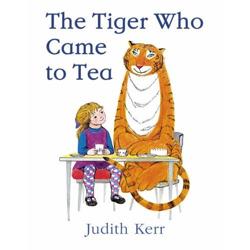
I remember reading this book over and over when I was little! I loved the fact that Sophie couldn't have a bath because the tiger had drunk all the water in the taps.
Activity: Make a tiger!
Resources: black, orange, red and white A4 paper or card, scissors, glue, ruler, eraser.
What to do:
1) Using a pencil and ruler divide paper into 1.5 cm strips.
 |
| 1. |
 2)
2) Do the same with the orange paper to make 4 strips, then fold the paper lengthways and cut out the strips. They should be 1.5 cm in width and half 10.5 cm long. Do this with the white paper too.
3) Cut the white and orange strips out and start to glue them onto your black paper, using the pencil lines as guides. For the third orange strip, the one with the ears, add two circular shapes onto the end of an orange strip. To make the legs, use 4 cm long strips.
 |
| 3. |
4) To make the tigers jaw and mouth, Use a strip double the width of the others - (3 cm) and 14cm long. Draw and cut out the shape below in picture 4, and stick it on, above the legs.
 |
| 4. |
 |
| 5. |
5) Now for the head. With your orange paper, draw a shape like the one in Picture 6. It measures 6cm by 11cm. Cut out two 1.5cm wide strips as shown, to make the rest of each of those strips 7cm. Cut the shape out and make the sides of the strips that poke out, curved.
 |
| 6. |
6) Add two white stripes for the side of the face and make their side edge a little curved.
 |
| 7. |
7) Add eyes and a nose and you are done! Oh and don't forget to rub out your pencil lines! :-)
I got the idea for this tiger from this Tom Eckersley print.
http://pinterest.com/pin/47076758575083851/






















































